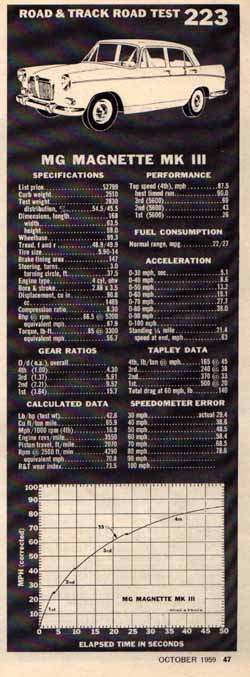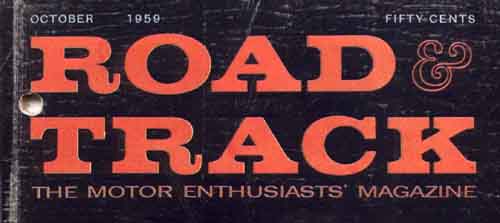


This is the original Road & Track Road Test, Number 223, from October 1959. No author was listed.
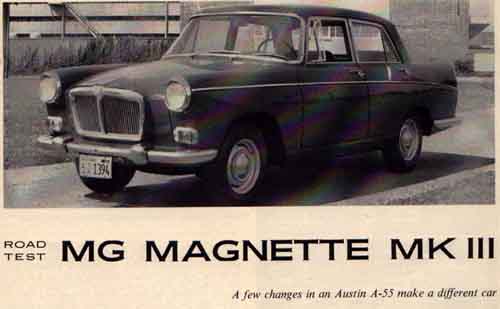
The third MG sedan of the postwar series was announced a few months ago. Although this new model by BMC is very similar in most respects to the Austin A-55 sedan tested recently (July 1959), it incorporates a number of small but important changes in specifications. As sports-car enthusiasts, we think these changes make this car considerably more interesting than the Austin. Our interest in the new Magnette was further heightened by the fact that it has been five years since our last test of one; there had been very minor changes in all that time. The Magnette differs from the A-55 in obvious ways: a stylized MG grille, a more expensive interior with genuine leather, different trim details, etc. It also differs in certain mechanical terms, particularly a twin-carburetor version of the BMC series B engine (virtually identical to that used in the MG-A 1500). Another important difference is a drop in the axle ratio, from the 4.55:1 of the Austin to 4.30:1, the same as used in the sports car. These two mechanical changes alter the entire character of the automobile.
We are not saying that the Magnette is a better car than the Austin for everyone. The Austin's forte is in city driving, as exemplified by its flexibility and brisk high-gear ability (a pulling power of 210 lb/ton). Under the same conditions (high gear), the Magnette pulls only 165 lb/ton, as might be expected from its lower numerical axle ratio combined with 70 lb more weight and reduced engine torque at low revs. Nevertheless, the Magnette's powerplant pulls remarkably well at low speeds. In fact, it pulls away from as low as 10-12 mph in high gear with only a slight shudder, and dawdling in traffic at 20 mph is very comfortable. In short, the “wilder” cam, twim carburetion, and 4.30 axle have their inevitable effect, but if we had not driven the Austin previously, the Magnette would have been rated quite docile and a fairly brisk high-gear performer.
The advantages of the aforementioned specification changes (over the Austin) are, to us, well worthwhile. Without a doubt the biggest advantage is a much higher cruising speed, with extra passing ability at 60 or 70 mph. Here the Magnette shines. As might be expected, the top speed is clearly better, with nearly 90 honest mph available under favorable conditions. As shown in the data panel, we achieved a best one-way timed run of exactly 90.0 mph, at which time the speedometer indicated between 91 and 92 mph. This was done with a moderate tail wind and the true mean speed (the best of two runs in opposite directions) was 87.5 mph. (In other words, the car was 5 mph slower against the wind.)
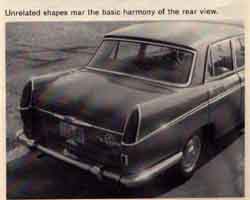
Acceleration tests, too, show the advantage of the Magnette over the Austin. Through the gears it gets to 60 mph nearly 2 sec quicker. Thus, though the Tapley pull readings in each gear are not quite so good as its sister's, the Magnette nevertheless is a more sporting vehicle which responds readily to proper use of the gears. In this connection, the gearbox is one of the best we have ever tried. Any driver who is familiar with a stick shift will find no difficulty in using the gears properly. Shifting either up or down is extremely easy and we never once heard the slightest crunch, even during the tests. The gear control itself is a short, floor-mounted lever, bent back slightly. This places the knob about 2 in. farther back than we like, but it would be easy enough to straighten it up a bit to eliminate this objection. Incidentally, the maximum speeds in gears, given in the data panel, show that the 6000-rpm potential of the MG-A sports-car engine does not hold true in the Magnette. Valve clatter sets in at speeds close to 5600 rpm (there is no tachometer). Apparently the valve spring pressures are lowered somewhat in this model to insure longer life, a feature we commend for what is, after all, a family sedan.
The engine proved to be smooth and quiet at all speeds, but there
is a slightly noticeable interior rumble when tinder the hood is the
basic engine of the MG-A 1500. cruising in the 60's. This may be due
to between the exhaust system and the unit-construction body. It is
barely noticeable at first, but might be annoying an all-day stint at
the wheel. Steering, as on the Austin, is not the best. In traffic
the car seems to wander but this tendency can be ignored by relaxing
and not trying to fight the wheel. At high speeds no such condition
appears; the car feels quite stable even when flat out. General
handling qualities are good though not outstanding. This is an
inherently understeering vehicle, is when the rear end breaks loose
the quick steering nearly instantaneous correction. In short, the car
has no vices, but it is not the best handling sedan we have
tried.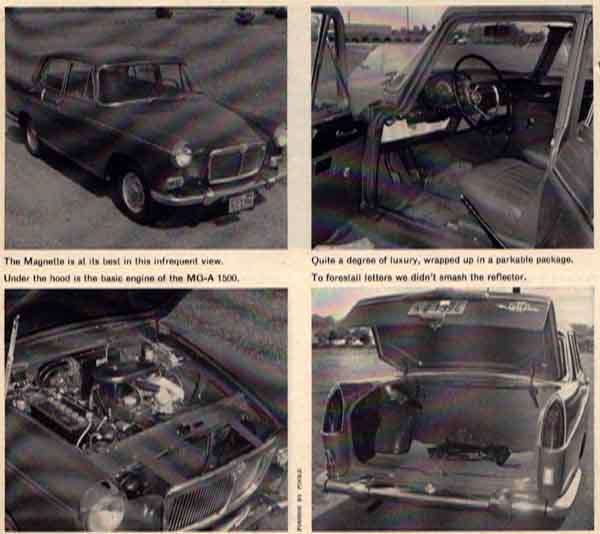
For reasons which we cannot fully explain, Magnette seems to ride noticeably better than the Austin (the chassis are identical). Possibly this was because Magnette had 4400 miles on the odometer as compared with barely over 1000 on the Austin (dampers and tend to loosen slightly with use).
Breaking in had evidently not improved the Magnette’s brakes: they tended to grab when cold, and brake squeal did not always disappear when they were warmed up. We believe this is not typical. Incidentally, the clutch seemed to be quite adequate and stood up well to some very severe treatment during the succession of standing-start trials necessary to get our usual acceleration data.
Wherever we went with the Magnette, we received favorable attention. Finished in a single-tone dark red and with Pinin Farina lines, it looks exceedingly attractive, and the unique but recognizable grille sets it apart from all other sedans. The 4 doors and moderately wrapped windshield make entrance and exit simple, a feature enhanced by the higher-than-average seats and roof line.
Individual front seats accommodate only two adults. Three can fit into the rear, although they are a little too squeezed to contemplate any extended touring. Upholstery material is genuine leather (red in the testcar),and soft enough to be comfortable as well as practical. Walnut trim is used effectively and wisely; it does not appear on horizontal surfaces where sun's rays can cause rapid deterioration. In general, all controls and switchgear well placed, but the inside front door handles are awkward.
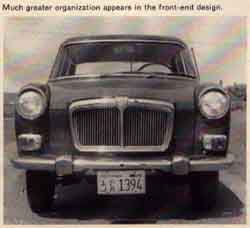
The instruments are grouped under a cowl which vaguely follows the motif of the radiator grille. To us the cowled area seems overly large, or else the 4 minor instruments are too small to fill the space adequately. Our suggestion would be to add a tachometer, for which there would be ample room if the speedometer face were made slightly smaller. Two knobs on the central panel provide for heating and ventilation. The latter gave a good supply of fresh air, but there was no opportunity to try the heater. A large undertray is supplied; this device is found on many English cars but is still strange to Americans. It is extremely useful despite the inclusion of a conventional locking glove box. Ash trays well forward on the inside of the front doors are also a clever touch. A unique gas tank location, directly behind the rear seat and over the rear axle, allows an extremely large and deep trunk space even with the spare wheel and tire underneath. The tank itself holds 12.5 U.S. gallons and has a convenient locking cover.
Finish on the Mk III Magnette--both inside and out--is superior to that of most of its competitors. Its performance is excellent, and even though it appeals primarily to the sports-car enthusiast with a family, it is also tractable and docile enough to be eminently satisfactory for the shopping housewife. We wonder, in fact, why BMC bothers to send over its other sedans with identical bodyshells but with less appeal to imported-car buyers.
